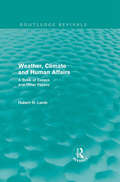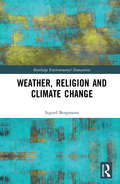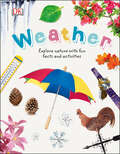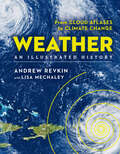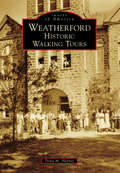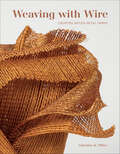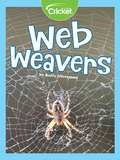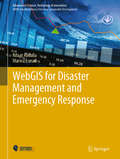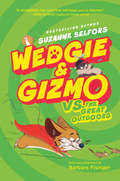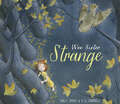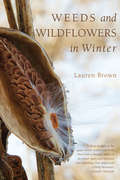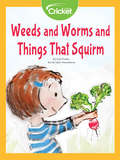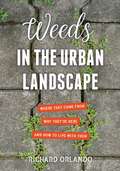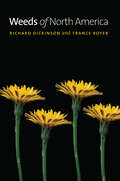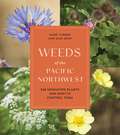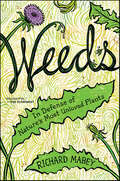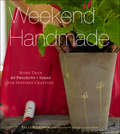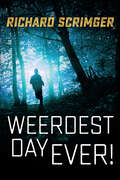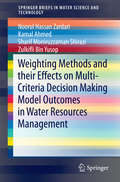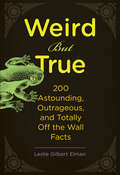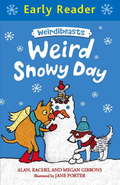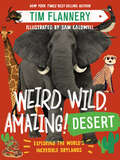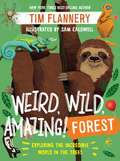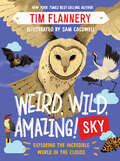- Table View
- List View
Weather, Climate and Human Affairs: A Book of Essays and Other Papers (Routledge Revivals: A History of Climate Changes)
by H. H. LambFirst published in 1988, this is a reissue of a groundbreaking collection of essays written by Hubert Lamb, one of the world’s foremost experts on weather and climate and a uniquely authoritative voice in the history of climatology. Hubert Lamb is able to provide a mature assessment of the effect of weather on people, and vice versa. His is a uniquely authoritative voice in the current debates about today’s environment and the prospects for the future. After a general introduction the book is divided into three parts. The first part consists of a chronological series of portraits of climate and its impact on human affairs and the environment. These extend from the warm climates of the geological past to the current drought in Africa. There are several studies of the last few centuries and, in particular, of the various effects of the so-called ‘little Ice Age’. The second part is concerned with the causes and mechanisms of climate and weather changes, including chapters discussing Christmas weather, fronts and volcanoes. In the final part Hubert Lamb looks to the future, and attempts to put into perspective some of the pessimistic forecasts currently available. The text, which is consistently authoritative but always readable, is augmented by numerous maps, diagrams and photographs.
Weather, Religion and Climate Change (Routledge Environmental Humanities)
by Sigurd BergmannWeather, Religion and Climate Change is the first in-depth exploration of the fascinating way in which the weather impacts on the fields of religion, art, culture, history, science, and architecture. In critical dialogue with meteorology and climate science, this book takes the reader beyond the limits of contemporary thinking about the Anthropocene and explores whether a deeper awareness of weather might impact on the relationship between nature and self. Drawing on a wide range of examples, including paintings by J.M.W. Turner, medieval sacred architecture, and Aristotle’s classical Meteorologica, Bergmann examines a geographically and historically wide range of cultural practices, religious practices, and worldviews in which weather appears as a central, sacred force of life. He also examines the history of scientific meteorology and its ambivalent commodification today, as well as medieval "weather witchery" and biblical perceptions of weather as a kind of "barometer" of God’s love. Overall, this volume explores the notion that a new awareness of weather and its atmospheres can serve as a deep cultural and spiritual driving force that can overcome the limits of the Anthropocene and open a new path to the "Ecocene", the age of nature. Drawing on methodologies from religious studies, cultural studies, art history and architecture, philosophy, environmental ethics and aesthetics, history, and theology, this book will be of great interest to all those concerned with studying the environment from a transdisciplinary perspective on weather and wisdom.
Weather: Explore Nature with Fun Facts and Activities (Nature Explorers)
by DKHow is a forecast predicted? What makes a rainbow? Packed with facts and activities, this book has these answers and more, and is a perfect introduction to the world of sun, snow, and rain for kids who are curious about nature.With amazing facts about fun topics like thunder and lightning, Weather lets kids have fun and be innovative as they learn through simple activities like cloudspotting and making a barometer. It includes information on weather found in every season of the year, so kids can discover how weather works no matter what it's doing outside.With its natural look and feel and its practical approach, Weather is sure to make learning a breeze for little explorers.Series Overview: DK's revised Nature Explorers series is a fantastic first set of books on the great outdoors for children ages 6 to 8. From birds to weather to the seashore and more, the key topics of each subject are explained with plenty of fun activities to do along the way, encouraging kids to investigate and record everything they see. Fully updated with a contemporary design, DK's Nature Explorer series is perfect for kids who are curious about the world outside and want to discover nature.
Weather: From Cloud Atlases to Climate Change (Union Square & Co. Illustrated Histories)
by Andrew Revkin Lisa Mechaley&“Beautifully illustrated . . . Think of this book like dining on tapas, boasting savory flavors, some unexpected, that constitute a satisfying whole.&” —Washington PostAndrew Revkin, strategic adviser for environmental and science journalism at the National Geographic Society and former senior climate reporter at ProPublica, presents an intriguing illustrated history of humanity&’s evolving relationship with Earth&’s dynamic climate system and the wondrous weather it generates. Colorful and captivating, Weather: An Illustrated History hopscotches through 100 meteorological milestones and insights, from prehistory to today&’s headlines and tomorrow&’s forecasts. Bite-sized narratives, accompanied by exciting illustrations, touch on such varied topics as Earth's first atmosphere, the physics of rainbows, the deadliest hailstorm, Groundhog Day, the invention of air conditioning, London&’s Great Smog, the Year Without Summer, our increasingly strong hurricanes, and the Paris Agreement on climate change.Written by a prominent and award-winning environmental author and journalist, this is a groundbreaking illustrated book that traces the evolution of weather forecasting and climate science.
Weatherford: Historic Walking Tours
by Trina M. HaynesWeatherford was settled in the 1850s, when the pioneers and Indians came for its rich soil and water sources. The mark of fame for Weatherford is the Goodnight-Loving Trail, which was driven by two cattle drivers, Charles Goodnight and Oliver Loving. Charles Goodnight, who was killed in an Indian attack, is buried in Weatherford, and a historical marker is placed at his grave in the historic Greenwood Cemetery. Cotton and watermelon were the popular industries, and watermelon festivals still bring crowds to the Courthouse Square. Over 150 images highlight Weatherford's historic town square buildings, the courthouse, homes, and cemeteries. Take a journey back into the 1800s with this photographic walking tour from the Courthouse Square to far and away. These images will bring back to life how Weatherford was built, how it survived, and the pioneers who kept its rich history alive.
Weaving with Wire: Creating Woven Metal Fabric
by Christine K. MillerLearn a new weaving technique using a wire warp and fiber weft on a multiharness loomUse the strong, flexible, malleable fabric to craft jewelry, baskets, sculpture, wall art, and moreIncludes woven-wire creations from author and other weavers with information to re-create them or use as inspiration
Web Weavers
by Buffy SilvermanGarden spiders belong to a group called orb weavers, which spin wheel-shaped webs. Some webs are funnel-shaped and some are very sticky. In this photo essay about different kinds of spider webs, readers will learn all about nature's masters of silk weaving.
WebGIS for Disaster Management and Emergency Response (Advances in Science, Technology & Innovation)
by Rifaat Abdalla Marwa EsmailThis book aims to help students, researchers and policy makers understand the latest research and development trends in the application of WebGIS for Disaster Management and Emergency Response. It is designed as a useful tool to better assess the mechanisms for planning, response and mitigation of the impact of disaster scenarios at the local, regional or national levels. It contains details on how to use WebGIS to solve real-world problems associated with Disaster Management Scenarios for the long-term sustainability. The book broadens the reader understanding of the policy and decision-making issues related to Disaster Management response and planning.
Webs of Life: Saguaro Cactus
by Paul FleisherThis series offers very young readers a glimpse at the ways in which plants and animals interact and affect one another in a specific community. Each book invites the reader to explore a certain microsystem's environment and the wide variety of creatures that have adapted to life there.
Wedgie & Gizmo vs. the Great Outdoors (Wedgie & Gizmo #3)
by Suzanne Selfors Barbara Fisinger“A delightfully fun read that will leave you in stitches!”—Caldecott Medalist Dan SantatFans of Stick Dog and My Big Fat Zombie Goldfish will LOL when rival pets Wedgie and Gizmo brave their first family camping trip in book three of bestselling author Suzanne Selfors’s hilarious illustrated series. Wedgie and Gizmo’s humans are taking their first family vacation—to a campground by a lake! And their pets are too destructive to stay home alone. Wedgie the corgi is super-excited. He can’t wait to chase squirrels and poop in the woods!But Gizmo, the evil genius guinea pig, has no time for games. He must convince the forest critters to join his Evil Horde and help him take over the world—one tent at a time.Muh-hah-hah!
Wee Sister Strange
by Holly Grant K. G. CampbellWith a lyrical text and gorgeous, ethereal illustrations, here is a mesmerizing and magical original bedtime fairy tale reminiscent of Emily Winfield Martin&’s Dream Animals, and perfect for reading aloud. They say there's a girl Who lives by the woods In a crooked old house With no garden but gloom. She doesn't have parents. No one knows her name. But the people in town Call her Wee Sister Strange. Like Emily Winfield Martin&’s bestselling Dream Animals, here is a bedtime read-aloud sure to entrance young listeners. Each evening, as the shadows grow long, Wee Sister Strange climbs from her window and runs into the woods. She talks to the owls and rides on a bear. She clambers up trees and dives into the bog. She is searching for something.... She looks far and wide, over forest and marsh. What is it she seeks? Why, it's a wee bedtime story to help her fall asleep!
Weeds and Wildflowers in Winter
by Lauren BrownThe help you need identifying the dormant but visible vestiges of spring and summer wildflowers and other plants. When it was first published, Roger Tory Peterson said of Weeds and Wildflowers in Winter (originally published as Wildflowers and Winter Weeds), "this book will be a joy to those wood-walkers and strollers who have been puzzled by the skeletal remains of herbaceous plants that they see in winter." And indeed, it has been in print for decades, helping both wood-walkers and botanists identify and better understand the weeds we see in winter. This charming guide identifies more than 135 common species of wildflowers and weeds found in the northeastern United States. Each plant is superbly illustrated with a full-page drawing accompanied by an elegant description of the plant's key characteristics. In addition, a step-by-step key to plant identifications and an illustrated glossary of common plant parts and botanical terms make this book an even more valuable resource. If you've ever wanted to know what those plants you see sticking up out the snow are, you'll appreciate this lovely, useful book.
Weeds and Worms and Things That Squirm
by Gail ParkerWhat kinds of plants grow in the garden? Carrots, radishes, and … a furry plant?
Weeds in the Urban Landscape: Where They Come from, Why They're Here, and How to Live with Them
by Richard OrlandoA comprehensive identification guide to 189 common weeds in the urban environment, explaining their families and characteristics, with strategies for managing their presence in the garden and fieldsThis engaging field guide for the urban explorer, gardener, or armchair enthusiast traces the history of weeds as they migrated out of the Middle East with human tribes and spread across Europe and the Americas, details the folklore surrounding them, and explains their role in the evolution of agriculture and human civilizations as well as their many uses for medicine, food, animal fodder, and soil enhancement. Richard Orlando provides detailed descriptions of 189 common weeds—found across the U.S.—describing their families and characteristics, and suggesting strategies for managing their presence in the garden and field. Abundant illustrations enhance the text and facilitate plant identification. An annotated bibliography and index of botanical names, in addition to a detailed explanation of Integrated Pest Management, make this an essential reference for anyone with an interest in the world outside our doors.
Weeds of North America
by France Royer Richard DickinsonAmerican Horticultural Society Book Award Winner: “An essential reference for all who wish to understand the science of the all-powerful weed.” —Better Homes and Gardens“What is a weed,” opined Emerson, “but a plant whose virtues have not yet been discovered?” While that may be a worthy notion in theory, these plants of undiscovered virtue cause endless hours of toil for backyard gardeners. Wherever they take root, weeds compete for resources, and most often win. They also wreak havoc on industry—from agriculture to golf courses to civic landscape projects, vast amounts of money are spent to eradicate these virile and versatile invaders. With so much at stake, reliable information on weeds and their characteristics is crucial. Richard Dickinson and France Royer shed light on this complex world with Weeds of North America.Organized by plant family, this encyclopedic volume features over five hundred species in two-page spreads with images and text identification keys. Species are arranged within family alphabetically by scientific name, and entries include vital information on seed viability and germination requirements. No matter what your philosophy on weeds, this guide provides much-needed background on these intrusive organisms. In the battle with weeds, knowledge truly is power, and Weeds of North America is perfect for gardeners, botanists, nature lovers, or anyone working in the business of weed ecology and control.“Royer’s photographs are almost perversely alluring. . . . How can you not be ensnared by a book populated by prostrate pigweed, tansy ragwort and dog-strangling vine?” —New York Times Book Review
Weeds of the Pacific Northwest: 368 Unwanted Plants and How to Control Them
by Mark Turner Sami GrayA comprehensive guide to the most common weeds of the Pacific Northwest, with essential information on their management and eradication Weeds are everywhere. They crowd out valuable agricultural crops, compete with the tomatoes and beans in your vegetable garden, spread rampantly along roadsides, and pop up from the tiniest cracks in sidewalks. In order to manage them, we must first learn how to identify them. Weeds of the Pacific Northwest is a guide to identifying, controlling, and eradicating over 300 species of weeds that gardeners and homeowners are likely to encounter in Northern California, Oregon, Washington, and British Columbia. Though they can all cause trouble, each weed is different. The hundreds of user-friendly photographs and detailed descriptions of each species here ensure that you can spot and treat any weed in your path. As the experts behind this book demonstrate, some plants can be killed by eating them, some by digging, some by smothering, and some only by the judicious application of chemical herbicides—and it is very important for you and your neighbors to know and understand the differences.
Weeds: In Defense of Nature's Most Unloved Plants
by Richard Mabey“[A] witty and beguiling meditation on weeds and their wily ways….You will never look at a weed, or flourish a garden fork, in the same way again.”—Richard Holmes, author of The Age of Wonder“In this fascinating, richly detailed book, Richard Mabey gives weeds their full due.”—Carl Zimmer, author of EvolutionRichard Mabey, Great Britain’s Britain’s “greatest living nature writer” (London Times), has written a stirring and passionate defense of nature’s most unloved plants. Weeds is a fascinating, eye-opening, and vastly entertaining appreciation of the natural world’s unappreciated wildflowers that will appeal to fans of David Attenborough, Robert Sullivan’s Rats, Amy Stewart’s Wicked Plants, and to armchair gardeners, horticulturists, green-thumbs, all those who stop to smell the flowers.
Weekend Handmade: More Than 40 Projects and Ideas for Inspired Crafting (Weekend Craft Ser.)
by Kelly Wilkinson&“Weekend Handmade provides instructions for quirky crafts that virtually anyone can do . . . Think hipster Martha Stewart&” (NPR Weekend Edition). In Weekend Handmade, author Kelly Wilkinson encourages readers to celebrate the joy of crafting, both for the satisfaction of making something by hand, and because the finished items serve as reminders of time taken to slow down and create—no matter the day of the week. The book is organized into three sections: &“Make&” offers projects to wear or decorate with; &“Grow&” presents projects inspired by gardens, fields, and farmer&’s markets; and &“Gather&” spotlights projects that enrich casual get-togethers. With clear, step-by-step instructions, every project in Weekend Handmade—from aprons, tablecloths, and marmalade to a memory box and a chandelier—can be completed in a few hours or over the course of a weekend. &“Think you can&’t make anything—or, more importantly, that you don&’t have the time to? Wilkinson&’s undowdy projects—luminarias, table decorations—are all designed to be completed in a couple of hours.&” —Entertainment Weekly
Weerdest Day Ever! (The Seven Prequels #4)
by Richard ScrimgerBunny is on a camping trip with his brother and his grandpa. How much trouble can he get into? As it turns out, a lot. For one thing, there are soldiers all over the place. Canada is about to go to war with the United States, and the battle starts tomorrow. Bunny is worried. A hockey rivalry is one thing, but this is serious. And why is everybody so happy? Things get personal when an American soldier steals his brother Spencer's cell phone. Bunny decides to track down the phone himself. Maybe they can get out of there before the war starts. That’s when things get confusing. . . In this zany prequel to Ink Meand The Wolf and Me, the hockey-loving, indomitable Bunny goes camping with his brother and his grandpa.
Weighting Methods and their Effects on Multi-Criteria Decision Making Model Outcomes in Water Resources Management
by Noorul Hassan Zardari Kamal Ahmed Sharif Moniruzzaman Shirazi Zulkifli Bin YusopThis book provides a systematic way of how to make better decisions in water resources management. The applications of three weighting methods namely rating, ranking, and ratio are discussed in this book. Additionally, data mining on keywords is presented using three popular scholarly databases: Science Direct, Scopus, and SciVerse. Four abbreviated keywords (MCDM, MCDA, MCA, MADM) representing multi-criteria decision-making were used and these three databases were searched for different popular weighting methods for a period of 13 years (2000-2012). The book provides also a review of weighting methods applied in various multi-criteria decision-making (MCDM) methods and also presents survey results on priority ranking of watershed management criteria undertaken by 30 undergraduate and postgraduate students from the Faculty of Civil Engineering, Universiti Teknologi Malaysia.
Weird But True: 200 Astounding, Outrageous, and Totally Off the Wall Facts
by Leslie Gilbert ElmanBizarre and fascinating facts for fans of science, nature, history, and more!The Earth is broadcasting a symphony of sound right now . . . Madagascar is home to enormous suicidal palm trees . . . Blacktip sharks can reproduce by virgin birth . . . In this fascinating book, weird, true facts like these reveal just how much freaky stuff really happens around the world.We’ve uncovered odd natural phenomena, super-strange historic occurrences, downright bizarre momentous discoveries, and totally peculiar coincidences that will blow your mind. From Biblical latrines to ultimate survivor microbes, if it’s weird—and true—you’ll find it here!
Weird Snowy Day: Book 4 (Weirdibeasts #4)
by Alan Gibbons Rachel Gibbons Megan GibbonsA full colour blue Early Reader story from million-copy-selling author Alan Gibbons writing with his daughters, Megan and Rachel.Early Readers are stepping stones from picture books to reading books perfect for building confidence in new readers and reluctant readers. A blue Early Reader is perfect for sharing and reading together. A red Early Reader is the next step on your reading journey.Katie Cat saw it first. It was a single white flake drifting down from the sky. It's a snowy day, and that means snowball fights and playing outside with friends. Even the littlest animals can have fun in the snow.A delightful new Weirdibeasts story from million-copy-selling author Alan Gibbons writing with his daughters, Megan and Rachel, and illustrated by Jane Porter.
Weird, Wild, Amazing! Desert: Exploring the World's Incredible Drylands
by Tim FlanneryInternationally renowned author and scientist Tim Flannery explores Earth’s deserts and grasslands and the extraordinary animals that live in them. Are zombie ants real? How high can an armadillo jump? What’s it like to wrestle a python? Tim Flannery has the answers. In this informed and accessible book, he introduces some of the most spectacular and unusual creatures in our planet’s deserts and grasslands with in-depth and often-bizarre facts. Flannery ties together concepts of climate change, evolution, conservation, and taxonomy throughout each animal’s profile, firmly connecting it to its environment while sparking wonder at its role in the natural world. Packed with vibrant illustrations and guided by real-life anecdotes from one of our greatest science communicators, Weird, Wild, Amazing! Desert teaches readers to cherish and delight in our planet’s ecosystems with Flannery’s signature mix of humor and wisdom.
Weird, Wild, Amazing! Forest: Forest
by Tim FlanneryInternationally renowned author and scientist Tim Flannery explores our planet’s forests and the extraordinary animals that live in them. Can spiders fly? Are dire wolves real? Do chameleons practice magic? Tim Flannery has the answers. In this informed and accessible book, he introduces some of the most spectacular and unusual creatures in Earth’s forests with in-depth and often bizarre facts. Flannery ties together concepts of climate change, evolution, conservation, and taxonomy throughout each animal’s profile, firmly connecting the animal to its environment while sparking wonder at its role in the natural world. Packed with vibrant illustrations and guided by real-life anecdotes from one of our greatest science communicators, Weird, Wild, Amazing! Forest teaches readers to cherish and delight in our planet’s ecosystems with Tim Flannery’s signature mix of humor and wisdom.
Weird, Wild, Amazing! Sky: Exploring the Incredible World in the Clouds
by Tim FlanneryInternationally renowned author and scientist Tim Flannery takes readers to the skies to learn about the extraordinary animals that fly in them. Can owls swim? Do woodpeckers eat wood? Are vampire bats real? Tim Flannery has the answers. In this informed and accessible book, he introduces some of the most spectacular and unusual creatures soaring through Earth’s skies with in-depth and often-bizarre facts. Flannery ties together concepts of climate change, evolution, conservation, and taxonomy throughout each animal’s profile, firmly connecting it to its environment while sparking wonder at its role in the natural world. Packed with vibrant illustrations and guided by real-life anecdotes from one of our greatest science communicators, Weird, Wild, Amazing! Sky teaches readers to cherish and delight in our planet’s ecosystems with Flannery’s signature mix of humor and wisdom.
